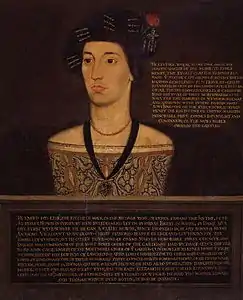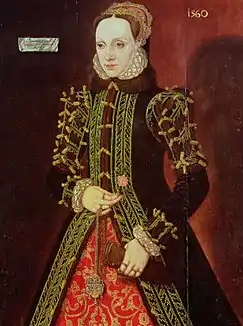Anthony Browne (died 1548)
Sir Anthony Browne, KG (c. 1500[1] – 6 May 1548) was an English courtier, Master of the Horse and a Knight of the Shire.


Life
He was the son of Sir Anthony Browne the Elder, Standard Bearer of England and Governor of Queenborough Castle, by his wife Lady Lucy Neville, a daughter of John Neville, 1st Marquess of Montagu, and the widow of Sir Thomas Fitzwilliam of Aldwark.[1] The younger Anthony was thereby a half-brother of William Fitzwilliam, 1st Earl of Southampton.
Anthony Browne's recorded royal services began in 1518, when he was appointed surveyor and master of hunting for the Yorkshire castles and lordships of Hatfield, Thorne, and Conisbrough. He was in an embassy to hand over Tournai to King Francis I of France. Thomas Howard, Earl of Surrey, knighted him on 1 July 1522. In 1525, he was made lieutenant of the Isle of Man. He was English ambassador to France in 1527, reporting home in increasingly anti-French terms.
By 1528, Browne had married Alice Gage, daughter of Sir John Gage and Philippa Guildford, and by her had seven sons and three daughters including:[1]
- Anthony Browne, later created Viscount Montagu;
- Mary Browne, who married John Grey of Pirgo and was the mother of Henry Grey, 1st Baron Grey of Groby;
- Mabel Browne, who married Gerald FitzGerald, 11th Earl of Kildare; and
- William Browne, who married Anne Hastings.
During the uprisings in Lincolnshire and Yorkshire in 1536, known as the Pilgrimage of Grace, King Henry VIII of England sent Browne to contend with the Roman Catholic protesters in order to test his loyalty. Browne executed the task and maintained the King's trust from then on.
Browne was elected to the House of Commons of England as a Knight of the Shire for Surrey in 1539 and was elected again in 1542, 1545, and 1547. In 1539, he was appointed as Master of the Horse, a position he kept until his death.
In January 1540, when King Henry VIII went to Rochester to meet his future fourth wife, Anne of Cleves, he first sent Browne, as his Master of the Horse, into her chamber. Browne later declared that he was never more dismayed in his life, "lamenting in his heart to see the Lady so far unlike that which was reported". Henry VIII confided his own disappointment the next day to Browne as they returned to Greenwich by barge.[2]
In 1540, Browne was made a Knight of the Garter and granted Battle Abbey, a property which had come into the hands of the Crown in 1538 as a result of the Dissolution of the Monasteries, which he turned into a country house.[3]

Sometime after 1540, his wife Alice having died, Anthony Browne married secondly Lady Elizabeth Fitzgerald, daughter of Gerald FitzGerald, 9th Earl of Kildare, and Lady Elizabeth Grey. They had two children who both died young. Lady Elizabeth was one of the great beauties of the Court, known as " the fair Geraldine". Later, after his death, she married Edward Clinton, 1st Earl of Lincoln.
In 1542, on the death of his elder half-brother, the Earl of Southampton, Browne inherited from him Cowdray House, a residence that would remain in his family for generations to come.
Browne had to be careful not to be brought down by factional politics at the court of King Henry VIII. He became so trusted by the king, that in his latter years Browne held a dry stamp of the King's signature, to use for minor letters. By 1547, he was Keeper of Oatlands Palace.
Anthony Browne died on 6 May 1548 at Byfleet in Surrey, and was buried in a tomb with his first wife, Alice. He was succeeded in his estates by his eldest son, Anthony Browne, who was later created Viscount Montagu.
King's mistresses
Two members the Browne family were reported to have been among the mistresses of Henry VIII. One of these, recorded only as a 'Mistress Browne', was allegedly his sister. This lady was stated to have been a prime mover in the downfall of Anne Boleyn, which is consistent with her being Browne's sister Elizabeth Somerset, Countess of Worcester, who was a lady-in-waiting to Queen Anne Boleyn and the chief witness against her at her trial for adultery. Another less closely-related member of Browne's family, Anne Bassett, was rumoured to be in the running to become Henry VIII's fifth wife, and there were rumours of an earlier affair, shortly before the king's marriage to Anne of Cleves in January 1540.[4]
References
- Bindoff. The History of Parliament: the House of Commons 1509–1558, ed. S.T. Bindoff, 1982. 'BROWNE, Sir Anthony (c.1500–48), of Battle Abbey and Cowdray Park, Suss.'
- Strype, John, Ecclesiastical Memoirs, vol. 1 part 2, Oxford (1822), 456–458.
- "Houses of Benedictine monks: Abbey of Battle". British History Online. Retrieved 19 March 2016.
- Hart, Kelly (1 June 2009). The Mistresses of Henry VIII (First ed.). The History Press. ISBN 0-7524-4835-8.
- Dictionary of National Biography, Browne, Sir Anthony (d 1548), politician, by J A E Roundell. Published 1886.
| Political offices | ||
|---|---|---|
| Preceded by Sir Nicholas Carew |
Master of the Horse 1539–1548 |
Succeeded by Sir William Herbert |
| Honorary titles | ||
| Preceded by The Earl of Essex |
Captain of the Gentlemen Pensioners 1539–1548 |
Succeeded by Lord Braye |
| Preceded by new title |
Lieutenant and Keeper of Hampton Court Chase, Ranger of Bushy Park 1539–1548 |
Succeeded by Sir Michael Stanhope |
| Legal offices | ||
| Preceded by The Earl of Rutland |
Justice in Eyre (Justice of royal forests) north of the Trent 1546–1548 |
Succeeded by The Earl of Shrewsbury |